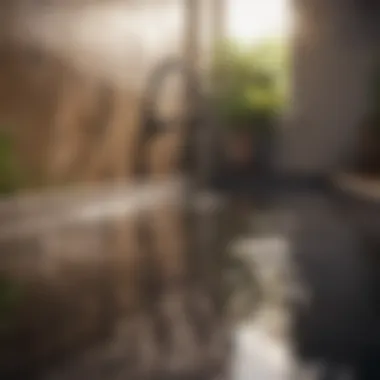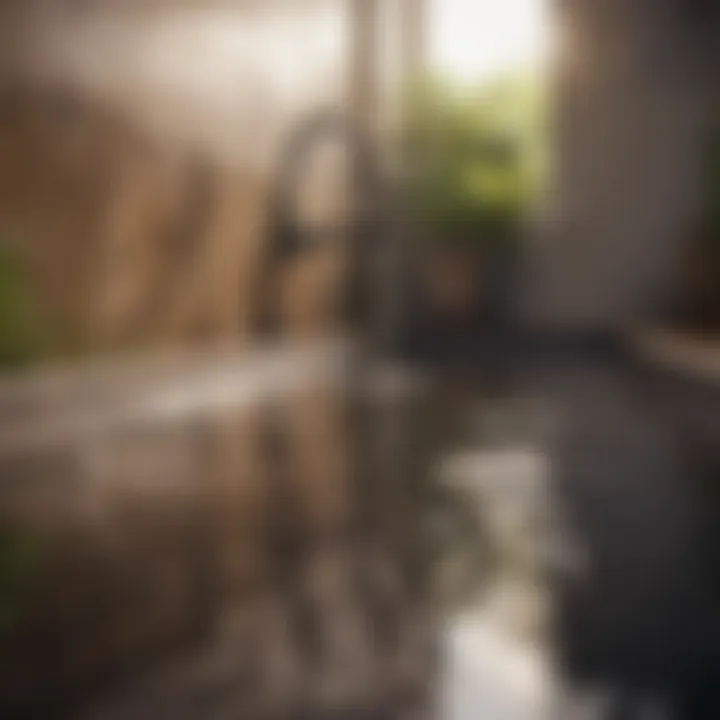Natural Solutions to Clear Clogged Drains Effectively


Intro
Clogged drains are a common household problem that can lead to frustration and inconvenience. When water refuses to flow freely, it disrupts daily activities and can even cause damage to plumbing systems. The typical response is often the use of harsh chemical cleaners, which not only pose risks to health but also damage pipes and the environment. This article examines natural methods to clear clogged drains effectively, providing practical solutions that are eco-friendly and easy to follow.
Understanding the common causes of clogged drains is important. From grease buildup in kitchen sinks to hair accumulation in bathroom drains, various factors contribute to this issue. By knowing these causes, homeowners can take preventive measures to avoid future clogs.
Furthermore, utilizing natural ingredients offers significant benefits. Many household items can serve as effective cleaning agents, reducing reliance on harmful chemicals. This guide will explore these ingredients, how they work, and provide step-by-step instructions for their use.
Ultimately, readers will gain insight into how to maintain their plumbing systems naturally, enhancing both functionality and environmental consciousness.
Feature Spotlight
Natural methods for clearing clogged drains stand out for their effectiveness and sustainability. The use of everyday ingredients is not only practical but also economical, making it accessible for all homeowners.
Natural Ingredients Overview
Some of the most common natural ingredients include:
- Baking Soda: Known for its ability to neutralize odors and loosen debris.
- Vinegar: Acts as a powerful agent to dissolve clogs and eliminate bacteria.
- Salt: Useful for breaking down residues and scouring pipes.
- Lemon Juice: Natural anti-bacterial that adds freshness to drains.
These ingredients can be combined to create powerful mixtures that tackle stubborn clogs without harsh effects. For instance, the combination of baking soda and vinegar creates a fizzing reaction that can help dislodge buildup.
Step-by-Step Clearing Techniques
- Baking Soda and Vinegar Method
Pour half a cup of baking soda down the drain, followed by half a cup of vinegar. Seal the drain with a plug or cloth and let it sit for about 30 minutes. Flush with boiling water afterward. - Salt and Baking Soda
Mix equal parts salt and baking soda, and pour down the drain. Follow with a pot of boiling water after an hour, allowing the mixture to dissolve any debris. - Lemon Juice Flush
Squeeze the juice of one lemon down the drain and leave it for 30 minutes. Flush with hot water to clean and refresh the pipes.
Employing these methods can drastically improve drainage performance and prevent future clogs without the negative effects of chemical cleaners.
"Natural solutions allow homeowners to maintain their plumbing systems while being considerate of the environment."
Epilogue
By integrating these natural solutions into routine maintenance, homeowners can cultivate a more efficient and environmentally friendly plumbing system. With a bit of understanding and practical application, difficult drain issues can be resolved naturally.
Understanding Clogged Drains
Understanding clogged drains is essential for homeowners looking to maintain their plumbing systems while avoiding costly repairs. Clogs can lead to various issues, including unpleasant odors, slow drainage, and potential damage to pipes if not addressed promptly. By gaining insights into the mechanics behind clogs, one can implement preventative measures and choose effective natural solutions.
Common Causes of Clogged Drains
Clogs typically arise from a combination of factors, with specific substances more likely to contribute to drainage issues. Being aware of these common causes can help individuals take proactive steps to avoid clogs in the first place. Below, we delve into four main culprits that often lead to clogged drains.
Hair and Soap Buildup
Hair and soap buildup is a primary factor in many household clogs. As hair washes down the drain, it intertwines with soap residues, forming a sticky mass that hinders the flow of water. The combination of these two substances creates a dense barrier, especially in bathroom sinks and showers. This issue is prevalent because hair is often not disposed of properly. Regular removal of hair from drains can prevent significant blockage.
Food Debris
Food debris represents another frequent cause of clogged drains, particularly in kitchen sinks. Leftover particles, grease, and other food remnants can accumulate over time, leading to a slow drain or complete blockage. A notable characteristic of food debris is its diversity; it can be anything from vegetable scraps to larger pieces of food. Homeowners often underestimate how even small amounts can contribute to drainage challenges. Ensuring proper disposal methods can mitigate this issue.
Grease Accumulation
Grease accumulation is a common problem, mainly due to cooking habits. When grease is poured down the drain, it cools and solidifies, creating a thick layer that restricts water flow. This characteristic makes grease particularly troublesome; it tends to mix with other debris, forming even larger clogs. Avoiding the disposal of cooking oils and greases through the sink is crucial to maintaining clear drains.


Foreign Objects
Foreign objects are often an overlooked cause of clogs. Items such as toys, paper products, and other non-disposable materials can accidentally make their way into the plumbing system, leading to unexpected blockages. This characteristic of foreign objects makes them particularly problematic, as their size and material can vary significantly, complicating removal efforts. Being mindful of what goes down the drain is essential to prevent unintentional clogs.
Understanding these primary causes of clogged drains enables homeowners to adopt more mindful practices in their daily routines. By addressing these elements, it becomes easier to implement effective natural solutions.
Importance of Natural Solutions
To address the issue of clogged drains, it is vital to understand the significance of natural solutions. Many homeowners often rely on chemical drain cleaners due to their convenience. However, these products can have detrimental effects on both health and the environment. By choosing natural methods, individuals can effectively manage drainage issues while minimizing potential risks associated with chemical agents.
Natural solutions are not only effective but also promote a more sustainable lifestyle. This approach aligns with a growing awareness of environmental conservation. People are increasingly looking for ways to maintain their homes without causing harm to ecosystems. Utilizing natural remedies supports this objective by using ingredients that are typically non-toxic and biodegradable.
Moreover, the importance of these solutions extends to health considerations. Chemical drain cleaners can release harmful fumes and leave residues that may compromise indoor air quality. Natural methods do not harbor such risks, making them preferable for families and pets. By adopting these techniques, individuals foster a healthier living environment.
Advantages of Natural Remedies
Environmental Considerations
Natural remedies offer significant environmental benefits. Unlike their chemical counterparts, they reduce environmental pollution. Many commercial drain cleaners contain harsh substances that can contaminate water systems. In contrast, natural solutions primarily involve household items that are safe for the environment. For example, ingredients like baking soda and vinegar break down naturally and do not contribute to toxic waste.
Their eco-friendly nature makes them a popular choice for individuals aiming to lessen their ecological footprint. Additionally, using natural products helps prevent damage to pipes and plumbing systems that may occur from corrosive chemical cleaners.
Health Benefits
Another compelling aspect of natural remedies is their health benefits. Chemical drain cleaners can emit vapors that irritate respiratory systems or cause allergic reactions. Natural alternatives, on the other hand, do not pose similar health risks. With ingredients like lemon juice or salt, homeowners can clear clogs without fear of harmful side effects.
This aspect is particularly important for households with children or pets. The safety of using non-toxic alternatives cannot be understated. Such remedies provide a practical solution to clogs while ensuring that the home remains a safe space for family members.
Cost-Effectiveness
Cost-effectiveness is another advantage of using natural solutions. Chemical cleaners can be expensive and may require frequent purchases if clogs persist. In contrast, natural ingredients such as vinegar, baking soda, and salt are usually readily available at home or can be bought at a lower price.
By investing in natural remedies, homeowners can save money over time. They also avoid the costs associated with potential pipe damage from chemical cleaners. Regular use of inexpensive natural methods contributes to long-term plumbing health, ultimately leading to additional savings.
"Opting for natural solutions not only remedies clogs but also contributes to monthly savings and enhances health and safety at home."
Choosing natural methods for clearing clogged drains embodies a commitment to sustainability, health, and economic prudence. By understanding these advantages, homeowners can make informed and responsible decisions regarding their plumbing maintenance.
Essential Natural Ingredients
In the quest to clear clogged drains, a solid understanding of essential natural ingredients is crucial. These ingredients not only offer effective solutions to drain issues but also do so in an environmentally friendly manner. Using natural substances reduces the chemical burden in our homes, making for a healthier environment. They are accessible and typically found in most households, making them convenient options for everyone.
Natural ingredients provide several benefits that are worth considering. For one, they are safer for both humans and pets compared to chemical cleaners. They are also often more cost-effective, saving on the expense of chemical products. Many of these ingredients possess antibacterial properties, which ensure deeper cleaning. Moreover, they can be safely disposed of without contributing to pollution.
Understanding how to use these ingredients can lead to effective solutions for clogs that might otherwise require professional intervention. This section examines some of the most effective and well-known natural options for unclogging drains, ensuring you are well-equipped with information to tackle any plumbing issue.
Baking Soda and Vinegar
Baking soda and vinegar form a classic combo in natural drain cleaning. Baking soda acts as a mild alkali, facilitating the breakdown of debris. When combined with vinegar, it creates a fizzing reaction, helping to loosen stubborn clogs. To use this method:
- Pour half a cup of baking soda down the drain.
- Follow it with half a cup of vinegar.
- Cover the drain with a cloth and let it sit for about 30 minutes.
- Finally, flush the drain with hot water.
This technique not only cleans the pipes but also helps in neutralizing odors.
Salt


Salt is often overlooked but serves as an effective natural solution. It works by drawing moisture out of food particles and grease accumulations, leading to a breakdown of the clog. It can be used in different ways:
- Mix two cups of salt with two cups of boiling water.
- Pour the mixture down the drain slowly.
- Let it sit for a couple of hours or overnight.
- Flush with hot water.
This method is beneficial because it is simple yet powerful, and it can be repeated as needed without harming pipes.
Lemon Juice
Lemon juice is not only a cooking staple but also a potent natural cleaner. Its acidity helps to break down grease while leaving a fresh scent. To use lemon juice for clearing drains:
- Extract the juice from one or two lemons.
- Pour it down the clogged drain.
- Wait for about 30 minutes before flushing with hot water.
This method offers not only a cleaning benefit but also adds a pleasant fragrance to your plumbing.
Boiling Water
Sometimes, the simplest technique is the most effective. Boiling water can break down minor clogs caused by grease or soap residue. Here’s how to use it:
- Boil a kettle full of water.
- Carefully pour the boiling water down the drain.
- Repeat two or three times if necessary.
This method is particularly useful for regular maintenance, as it can help prevent buildup before it becomes a significant problem.
In summary, the essential natural ingredients for clearing drains not only serve their purpose effectively but also align with safety and environmental considerations. Engaging with these natural solutions gives homeowners the tools to maintain their plumbing without relying on harsher chemical alternatives.
Step-by-Step Methods to Clear Drains
In addressing clogged drains, employing specific step-by-step methods is crucial. These methods not only offer practical solutions but also ensure that the chosen techniques are effective and safe for the environment. Understanding how to apply these methods can empower homeowners and enable them to take control over their plumbing issues without relying on harsh chemical cleaners. Each method is designed with accessibility in mind, so anyone can follow along. The following subsections will dissect various techniques, beginning with a combination of baking soda and vinegar, which are readily available in most households.
Using Baking Soda and Vinegar
Preparing the Drain
Proper preparation of the drain is crucial in this method. Before applying any solution, ensure that the drain is clear of excess water. This allows the baking soda and vinegar to work effectively. Additionally, physically removing any visible debris can enhance the process. This preparation is a prevalent step due to its straightforwardness and efficiency. The unique feature here is that it makes the subsequent application more effective by allowing a focused chemical reaction. By clearing the area, you increase the likelihood of a successful resolution to the clog.
Application Process
The application process involves pouring one cup of baking soda into the drain, followed by one cup of vinegar. This mixture creates a chemical reaction that can dissolve many types of debris. The explosive fizzing lifts and pushes clogs, making it an effective solution for minor blockages. This process is popular because it’s non-toxic, inexpensive, and easy to execute. However, one should be mindful to use the correct proportions to avoid under or overdoing the application, as this could minimize the expected results.
Flushing the Drain
After the reaction has settled, it is important to flush the drain with hot water. This will help to wash away the loosened debris. The flushing step finalizes the cleaning process. It can be considered the finishing touch that maximizes the effectiveness of the previous ingredients. Not flushing adequately could lead to incomplete cleaning and recurring issues in the future, making this step vital for long-lasting results.
Using Salt and Boiling Water
Mixing Ingredients
Salt is a formidable natural abrasive and, when combined with boiling water, forms a simple yet effective solution. Mixing approximately half a cup of salt with boiling water increases the solution's impact on the clog. This is a beneficial choice because it combines ease with effectiveness. The unique feature of this mixture is its ability to cut through grease while also serving as a scour for any stuck remains in the pipe. However, one consideration is that too much salt can lead to potential corrosion in older pipes, making moderation key.
Foreword Procedure
The introduction procedure consists of slowly pouring the salt solution directly into the drain. This ensures that the abrasive properties of the salt can interact more effectively with the blockage. Gradual introduction is a best practice as it prevents sudden pressure changes that could damage pipes. This step is essential as the focused application increases the likelihood of success without overwhelming the drainage system.
Post-Cleaning Steps
After the initial application, it is pertinent to follow up with more boiling water to rinse away the remaining salt and debris. This final step ensures that the drain is not only clear but also free of any residual materials that may cause future blockages. Its importance lies in re-establishing the flow in the drain. Unattended remained materials could lead to recurring clogs, hindering the effectiveness of your cleaning efforts.


Employing Lemon Juice
Extracting Juice
Extracting juice from fresh lemons provides a citric solution with cleaning properties. This method emphasizes using freshly squeezed juice to maximize its efficacy. The benefit of lemon juice lies in its natural composition and ability to break down grease and grime. Using fresh juice is preferable over bottled alternatives due to its concentrated levels of citric acid. However, the downside is that the extraction process can be a bit time-consuming, especially if using multiple lemons.
Application Techniques
The application involves pouring the extracted lemon juice directly into the drain. Follow up with hot water to activate the cleaning properties of the juice. This step is not only effective but also imparts a fresh scent. This method is favored among households that seek eco-friendly solutions. Nonetheless, it may not be as effective for stubborn clogs. The characteristic of the technique is its simplicity and appeal to those who prefer organic substances.
While Flushing with Water
Flushing with warm water post-application clears away any loosened debris resulting from the lemon juice. This step is essential as it ensures thorough cleaning. Properly flushing the system significantly boosts the effectiveness of the earlier steps. An important aspect of this processes is to allow lemon juice ample time to sit in the drain, enabling it to work on the build-up effectively. Without adequate flushing after the treatment, residual materials may still remain.
Preventing Future Clogs
Preventing future clogs requires proactive measures. Clogged drains can lead to inconveniences and costly repairs. A little attention to routine maintenance can go a long way in keeping your plumbing system running smoothly. This section emphasizes various methods to avoid recurring clogs, focusing on good habits that homeowners can adopt. The benefits include saving time and reducing the need for harsh chemicals.
Routine Maintenance Practices
Regular Cleaning Schedule
Establishing a regular cleaning schedule is vital for effective drain maintenance. This approach contributes significantly to preventing clogs by ensuring that buildup is addressed before it causes issues. Regularity can mean different things, such as monthly or quarterly cleaning, depending on usage levels. Key characteristics of a schedule include reliability and consistency, making it easier to incorporate into daily routines.
For example, scheduling a cleaning at the start of each month allows for the removal of accumulated materials like hair and grease. This pattern fosters a habit of checking drains frequently. The main advantage of this practice is that it reduces the likelihood of severe clogs developing, saving homeowners from urgent situations.
However, a disadvantage could be neglecting the schedule due to other priorities. Still, the benefits often outweigh this risk.
Disposal Best Practices
Disposal best practices also play a significant role in maintaining clear drains. What you put down your sink can have lasting effects. Understanding proper disposal is an essential aspect of this topic. The key characteristic of these practices is a mindful approach to waste management. Opting to dispose of food scraps in compost bins instead of the sink can notably diminish the chances of clogs.
A unique feature of best practices involves being informed about environmentally-friendly waste disposal options. This awareness supports not just the drainage system but also environmental sustainability. A notable advantage is the reduced chance of clogging, which means less frequent use of chemical cleaners that can harm plumbing and ecosystems.
Despite the benefits, people may find it hard to change long-standing habits related to waste disposal. Nevertheless, adopting these best practices leads to significant improvements over time.
Using Drain Screens
Utilizing drain screens is a practical method of preventing clogs. These simple devices act as barriers, catching debris before it enters the plumbing system. This preventative measure is easy to implement and maintain. By blocking hair, soap, and food particles, drain screens ensure a cleaner drain opening.
The advantages speak for themselves. They not only cut down on the amount of buildup leading to clogs but also minimize the frequency of required cleaning. Drain screens are accessible and come in various styles to fit different drains.
In summary, adopting these preventative measures is essential for every homeowner. By understanding regular maintenance and disposal best practices, along with utilizing drain screens, it is feasible to keep drains clear and functioning efficiently. Feeling good about your plumbing maintenance fosters a stress-free environment in your home.
Closure
Summary of Techniques
Recapping the techniques discussed, we find that several natural remedies stand out.
- Baking Soda and Vinegar: This classic combination is known for its fizzing reaction that can effectively lift stubborn debris from pipes.
- Salt and Boiling Water: Employing these two ingredients can dissolve grease and other materials, leading to clearer drains.
- Lemon Juice: The acidity of lemon juice works well against mineral buildups, making it an excellent option for regular maintenance.
Each of these methods has been detailed with precise steps in the previous sections, ensuring readers can follow along easily
Final Thoughts on Natural Drain Cleaning
As we wrap up this discussion, it is clear that natural drain cleaning methods provide a robust alternative to chemical solutions. Not only do these methods promote sustainability, but they also safeguard health by minimizing exposure to harmful substances. Routine use of these techniques can lead to a well-maintained plumbing system, reducing the likelihood of future clogs. For eco-conscious homeowners, embracing these practices offers an impactful way to care for the environment while managing household duties.
"A sustainable home promotes both physical and environmental health."
With a little commitment and knowledge, anyone can maintain their drainage system effectively.







